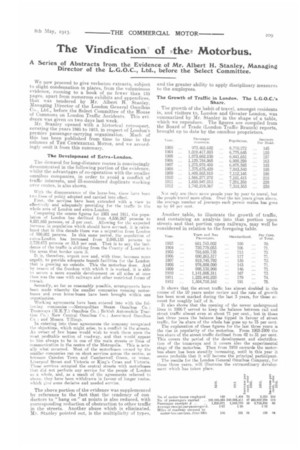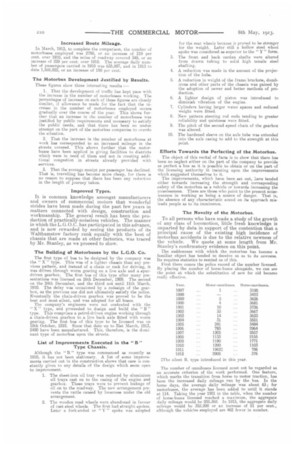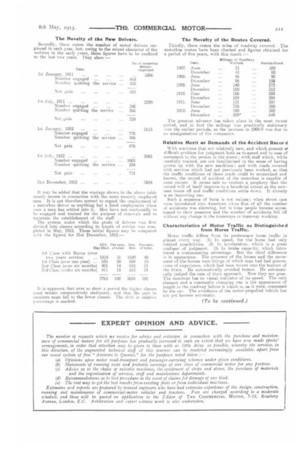The Vindication of the Motorbus.
Page 17

Page 18

Page 19

If you've noticed an error in this article please click here to report it so we can fix it.
A Series of Abstracts from the Evidence of Mr. Albert H. Stanley, Managing Director of the L.G.O.C., Ltd., before the Select Committee.
We now proceed to give verbatim extracts, subject to slight condensation in places, frcm the voluminous evidence, running to a book of no fewer than 135 pages, apart from numerous exhibits and appendices, that was tendered by Mr. Albert H. Stanley, Managing Director of the London General Omnibus Co., Ltd., before the Select Committee of the House of Commons on London Traffic Accidents. This evidence was given on two days last week. Mr.. Stanley opened with a historical retrospect, covering the years 1895 to 1913, in respect of London's premier passenger-carrying organization. Much of this has been published from time to time in the columns of THE COMMERCIAL MOTOR, and we accordingly omit it from this summary.
The Development of Extra-London.
The demand for long-distance routes is convincingly demonstrated in the following portion of the evidence, whilst the advantages of co-operation with the smaller omnibus companies, in order to avoid a conflict of traffic interests, and ill-considered duplicate working over routes, is also shown.
With the disappearance of the horse-bus, there have been two lines of policy adopted and carried into effect. First, the services have been extended with a view to effectively and adequately providing for the traffic in the whole area of London and extra-London.
Comparing the oensns figures for 1901 and 1911, the population of London has declined from 4,536,267 persons to 4,521,685 persons, or .3 per cent. Allowing for the expected increase in population which should have accrued, it is calculated that in this decade there was a migration from London of 550,801 persons. In this same period, the population of extra-London has increased from 2,045,135 persons to 2,729.673 persons or 33.5 per cent. That is to say, the incidence of the traffic is shifting from the County of London to the areas that, border upon it. It is, therefore, urgent now and, with time. becomes more urgent, to provide adequate transit facilities for the London that is growing up outside. This the motorbus does. And by reason of the freedom with which it is worked, it is able to secure a more equable development on all sides at once than was the case with railways and other restricted forms of transit.
Secondly, so far as reasonably possible, arrangements have been made whereby the smaller companies running motorbuses and even horse-buses have been brought within one organization.
Working agreements have been entered into with tho follvirug companies : —Metropolitan Steam Omnibus Co. ; Tramways (M.E.T.) Omnibus Co.; British Automobile Traction Co.; New Central Omnibus Co. ; Associated Omnibus Co.: and Messrs. Tillings.
In entering into these agreements the company recognized the objections, which might arise, to a conflict in the streets. An owner of few buses would wish to work them upon the most profitable section of roadway, and that would appear to him always to be in one of the main streets or lines of communication in the centre of the Metropolis. This is actnally what occurred. Most of the motorbuees owned by the smaller companies ran on short services across the centre, as between Camden Town and Camberwell Green. or worse. Liverpool Street and Victoria or King's Cross and ictoria. These services occupied the central streets with motorbuses that did not perform any service for the people of London as a whole, and, as a result of the agreements referred to above, they have been withdrawn in favour of longer routes. which give some decisive and needed service.
The above portion of the evidence was supplemented by reference to the fact that the tendency of conductors to "hang on" at points is also reduced, with corresponding reduction of obstruction to other traffic in the streets. Another abuse which is eliminated. Mr. Stanley pointed out, is the multiplicity of types,
and he greater ability to apply disciplinary measures to the employees.
The Growth of Traffic in London. The L.G.O.C.'s Share.
The growth of the habit of travel, amongst, residents in, and visitors to, London and Greater London, was summarized by Mr. Stanley in the shape of a table, which we reproduce. The figures are compiled from the Board of Trade (London Traffic Branch) reports, brought up to date by the omnibus proprietors.
Not only arc there more people year by year to travel, but the people travel more often. Over the ten years given above, the average number of journeys each person makes has gone up by 64 per cent.
Another table, to illustrate the growth of traffic, and containing an analysis into that portion upon streets and that portion upon railways, may well be considered in relation to the foregoing table.
It shows that the street traffic has almost doubled in the course of the 10 years under review and the rate of growth has been most marked during the last 3 years, for these account for roughly half of it. It also shows that the opening of the newer underground lines in 1906-7 served to keep the balance between rail and street traffic almost even at about 71 per cent., but in these last three years the balance has tipped in favour of street traffic, for its share of the whole has gone up to 75 per cent. The explanation of these figures for the last three years is the rise in popularity of the motorbus. From 1903-1909 the bus share of the street traffic declined from 42 to 31 per cent. This covers the period of the development and electrification of the tramways and it covers also the experimental stage of the motorbus. Then from 1910 onwards the motorbus share has been steadily increasing, until in this year it seems probable that it will become the principal participant.
The results for the London General Omnibus Company, for these three years, will illustrate the extraordinary development which has taken place.
Increased Route Mileage.
In March, 1913, to complete the comparison, the number of motorbuses employed was 2750, or an increase of 219 per cent. over 1910, and the miles of roadway covered 348, or an increase of 229 per cent. over 1910. The average daily number of passengers carried in 1910 was 635,897, and in 1913 to date 1,588,822, or an increase of 150 per cent.
The Motorbus Development Justified by Results.
These figures show three interesting results :— 1. That the development of traffic has kept pace with the increase in the number of motorbuses working. The percentage's of increase on each of these figures are closely similar, if allowance be made for the fact that the increase in the number of motorbuses employed occurs gradually over the course of the year. This shows further that an increase in the number of motorbuses was justified by public requirements and necessary to satisfy the public needs, and that there has been no endue attempt on the part of the mutorbus companies to overdo the situation.
2. That the increase in the number of motorbuses at work has corresponded to an increased mileage in the streets covered. This shows further that the motorbuses have been applied in giving facilities to dietriets which were in need of them and not in creating additional congestion in streets already provided with services.
3. That the average receipt per passenger has declined, That is, travelling has become more cheap, for there is no reason to suppose that there has been any reduction in the length of journey 'taken.
Improved Types.
It is common knowledge amongst manufacturers and owners of commercial motors that wonderful strides have been made during the past few years in matters connected with design, construction and workmanship. The general result has been the production of practically-noiseless vehicles. The manner in which the L.G.O.C. has participated in this advance, and is now rewarded by seeing the products of its Walthamstow factory rank equally with the best of chassis that are made at other factories, was traced by Mr. Stanley, as we proceed to show.
The Building of Motorbuses by the L.G.O. Co.
The first type of bee to be designed by the company was the " X " type. This was of a lighter chassis than any previous pattern, and instead of a, chain or rack for driving, it was driven through worm gearing on a live axle and a spurdriven gearbox. The first bus of this type after many presentations was licensed on 16th December, 1909. The second on the 24th December, and the third not until 11th March, 1910. The delay was occasioned by a redesign of the gearbox, as the previous one did not ultimately satisfy the police. Eventually the chain-driven gearbox was proved to he the best and most silent, and was adopted for all buses.
The company's engineers were not contented with the " X " type, and proceeded to design and build the " B" type. This comprises a petrol-driven engine working through a chain-driven gearbox to a live back axle fitted with worm gearing. The first bus of this type to be licensed was on 18th October, 1910. Since that date up to 31st March, 1913, 2480 have been manufactured. This, therefore, is the dominant type of motorbus upon the streets.
List of Improvements Executed in tha "B" Type Chassis.
Although the " B " type was commenced as recently as 1910, it has not been stationary. A list of some improvemente carried out in the construction shows that care is constantly given to any details of the design which seem open to improvement.
1. The sheet-iron oil tray was replaced by aluminium oil trays cast on to the casing of the engine and gearbox. These trays were to prevent leakage of oil on to the roadway. The new arrangement prevents the rattle caused by looseness under the old arrangement.
2. The wooden road wheels were abandoned in favour of cast steel wheels. The first had straight. spokes. Later a fork-ended or " Y " spoke was adopted for the rear wheels because it proved to he stronger for the weight. Later still a hollow steel wheel opoke was considered as superior to the " Y " form.
3. The front and hack eardan shafts were altered from drawn tubing to solid high tensile steel shafting.
4. A reduction was made in the amount of the projection of the hubs.
5. A reduction in weight of the frame brackets, dumbirons and other parts of the chassis was gained by the adoption of newer and better methods of production.
6. A lighter design of piston was introduced to diminish vibration of the engine.
7. Cylinders having larger water spaces and reduced weight were fitted.
8. New pattern steering rod ends tending to greater reliability and quietness were fitted.
9. The pitch of the second speed chain of the gearbox was altered.
10. The hardened sleeve on the axle tube VVRS extended into the axle casing to add to the strength at this point.
Efforts Towards the Perfecting of the Motorbus.
The object of this recital of facts is to show that there has been no neglect either on the part of the company to provide as perfect a bus as it is possible to obtain or on the part of the licensing authority in insisting upon the improvements which suggested themselves to it.
The improvements, which have been set out, :lave tended either towards increasing the strength and corresponding safety of the motorbus as a vehicle or towards increasing the noiselessness. There are those who point to the present noiselessness in working as being a source of danger. That is, the absence of any characteristic sound on it approach misleads people a,s to its imminence.
The Novelty of the Motorbus.
To all persons who have made a study of the growth of any class of locomotion, little fresh knowledge is imparted by data in support of the contention that a principal cause of the existing high incidence of motorbus accidents is due to the relative newness of the vehicle. We quote at some length from Mr. Stanley's confirmatory evidence on this point.
The suddenness with which the motorbus has become a familiar object has tended to deceive us as to its newness. Its requires statistics to remind us of this.
First there comes the police record of the number licensed. By placing the number of horse-buses alongside, we can see the point at which the substitution of new for old became really effective.
The number of omnibuses licensed must not be regarded as an accurate criterion of the work performed. One feature, which marks the transition from horse to motor traction, has been the increased daily mileage run by the bus. In the horse days, the average daily mileage was about 63; for motorbuses, the average has been added to until it stands at 114. Taking the year 19CI1 in the table, when the number of horse-buses licensed reached a maximum, the aggregate daily mileage would be 235,368. In 1913, the aggregate daily mileage would be 355.200 or an increase of 51 per cent., although the vehicles employed are 462 fewer in number.
The Novelty of the New Drivers.
Secondly, there comes the number of motor drivers employed in each year, but, owing to the mixed character of the services in the early years, these figures have to be confined to the last two years. They show :— _ It may be added that the wastage shown in the above table mostly occurs in connection with the more recently employed men. It is not therefore correct to regard the employment, of a motorbus driver as anything but a. fixed employment when once a man has settled into it. Men have not continually to be engaged and trained for the purpose of renewals and to maintain the. establishment of the staff.
The system under which the grade of drivers was first divided into classes according to length of service was completed in May, 1912. These initial figures may be compared with the figured for 31st December, 1912:
It is apparent that over so short a period the higher classes must remain comparatively stationary, and that the gain in numbers must fall to the lower classes. The shift in relative percentage is marked.
Relative Merit or Demands of the Accident Recor d
With machines that are relatively new, and which present as difficult problem for judgment both as to speed and to ease of movement to the person in the street ; with staff which, while carefully trained, are not familiarized in the sense of having grown up with the new machines ; and with roads covered with services which had not previously been worked, so that the traffic conditions of those roads could be memorized and known, the record of accident of the motorbus is capable of some excuse. It seems safe to venture a. prophecy that the record will of itself improve to a beneficial extent as the newness wears off and traffic conditions settle down. It already is an improving one.
Such a sequence of fade is not unique; when street ears were introduced into American cities first of all the number of accidents was alarming, but in time people became accustomed to their presence and the number of accidents fell off without. any change in the tramways or tramway working.
Characteristics of Motor Traffic as Distinguishe d from Horse Traffic.
Motor traffic differs from its predeceseor horse traffic in almost every way. (1) In speed, for the horse had only limited possibilities. (2) In acceleration, which is a great. confuser of judgment. 13) In brake capacity, which introduced a compensating advantage. But the chief difference is in appearance. The presence of the horses and the movement of the horses were things of which man had had generations of experience, which had been woven into the texture of the brain. He automatically avoided horses. He automatically judged the rate of their approach. Now they are gone. The motorcar has no visual indicator of its speed. The only element and a constantly changing one is the appearance of length in the roadway before it which is, as it were, consumed by the car. The avoidance of the motor-propelled vehicle has not yet become automatic.


























